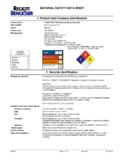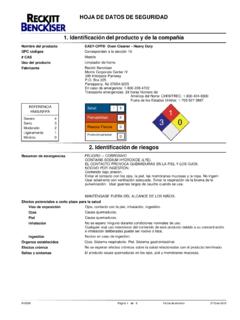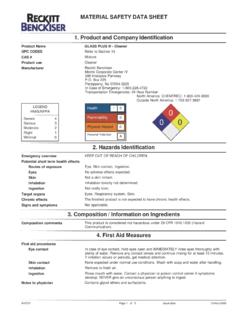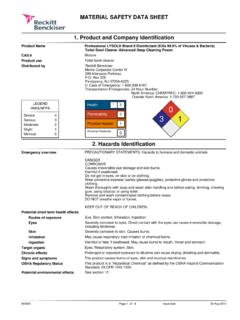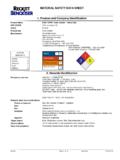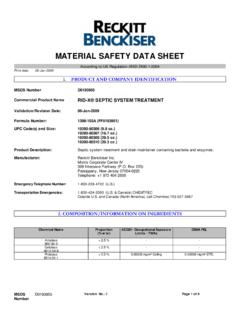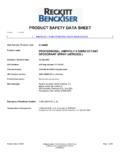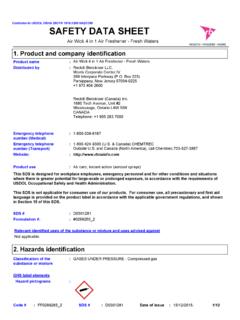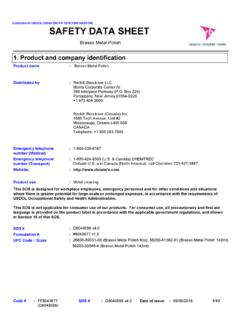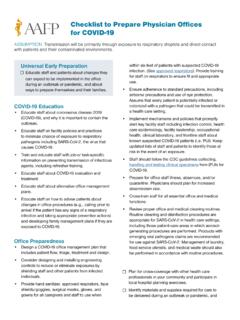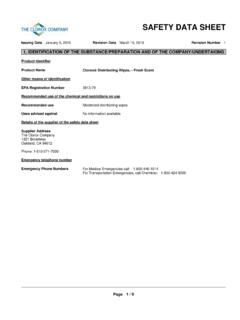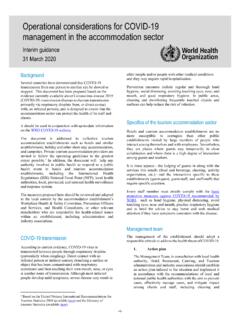Transcription of Lysol disinfecting wipes kills antibiotic resistant ...
1 Lysol Brand II kills of Viruses & Bacteria** disinfecting wipes Crisp Linen Scent, Citrus Meadows Scent, Lemon & Lime Blossom Scent, Lemon Scent,Ocean Fresh Scent, Fresh ScentSurface DATA SHEETP roduct nameDistributed byProduct use1. Product and company identification:::D8169502 :SDS #EPA ID #:: Lysol Brand II kills of Viruses & Bacteria** disinfecting wipes - Crisp Linen Scent- Citrus Meadows Scent- Lemon & Lime Blossom Scent- Lemon Scent- Ocean Fresh Scent- Fresh ScentUPC Code / Sizes: wipe impregnated with liquid (Loading ratio 4:1 (premix: wipe ) / 35, 80 and 110 count wipe in HDPE canister): Lysol Brand II kills of Viruses & Bacteria** disinfecting wipes Crisp Linen Scent, Citrus Meadows Scent, Lemon & Lime Blossom Scent, Lemon Scent, Ocean Fresh Scent, Fresh Scent:Website: telephone number (Medical)Emergency telephone number (Transport):1-800-338-61671-800-424-9300 ( & Canada) CHEMTREC Outside and Canada (North America), call Chemtrec:703-527-3887.
2 This SDS is designed for workplace employees, emergency personnel and for other conditions and situations where there is greater potential for large-scale or prolonged exposure, in accordance with the requirements of USDOL Occupational Safety and Health SDS is not applicable for consumer use of our products. For consumer use, all precautionary and first aid language is provided on the product label in accordance with the applicable government regulations, and shown in Section 15 of this to USDOL OSHA 29 CFR HAZCOMR eckitt Benckiser Corporate Center IV 399 Interpace Parkway ( Box 225)Parsippany, New Jersey 07054-0225 +1 973 404 2600 1/115/26/2016 Date of issue:SDS #D8169502_US:Code #D8169502 :D8169502 to USDOL OSHA 29 CFR HAZCOM2. Hazards identificationClassification of the substance or mixtureNot classified:Signal word:No signal statements:No known significant effects or critical pictograms:GHS label elementsSupplemental label elements:None not otherwise classified:None :Not :Not :Not :Not applicable.
3 :Read label before use. Keep out of reach of children. If medical advice is needed,have product container or label at statementsNot Composition/information on ingredientsMixture:Substance/mixtureEthy l alcohol1 - nameCAS number%There are no additional ingredients present which, within the current knowledge of the supplier and in the concentrations applicable, are classified as hazardous to health or the environment and hence require reporting in this concentration shown as a range is to protect confidentiality or is due to batch First aid measuresWash out mouth with water. Remove victim to fresh air and keep at rest in a position comfortable for breathing. If material has been swallowed and the exposed person is conscious, give small quantities of water to drink. Do not induce vomiting unless directed to do so by medical personnel. Get medical attention if symptoms flush eyes with plenty of water, occasionally lifting the upper and lower eyelids.
4 Check for and remove any contact lenses. Get medical attention if irritation contaminated skin with plenty of water. Remove contaminated clothing and shoes. Get medical attention if symptoms victim to fresh air and keep at rest in a position comfortable for breathing. Get medical attention if symptoms contactSkin contactInhalationIngestion::::Descriptio n of necessary first aid measuresMost important symptoms/effects, acute and delayedInhalation:No known significant effects or critical cause eye irritation upon direct contact with eyes.:Eye contactPotential acute health effects2/115/26/2016 Date of issue:SDS #D8169502_US:Code #D8169502 :D8169502 to USDOL OSHA 29 CFR HAZCOM4. First aid measuresProtection of first-aiders:No action shall be taken involving any personal risk or without suitable to physician:Treat symptomatically. Contact poison treatment specialist immediately if large quantities have been ingested or treatments:No specific known significant effects or critical hazards.
5 :IngestionSkin contact:No known significant effects or critical signs/symptomsSkin contactIngestionInhalationNo specific specific specific data.:::Eye contact:No specific toxicological information (Section 11)Indication of immediate medical attention and special treatment needed, if necessary5. Fire-fighting measuresPromptly isolate the scene by removing all persons from the vicinity of the incident if there is a fire. No action shall be taken involving any personal risk or without suitable thermal decomposition productsSpecific hazards arising from the chemicalDecomposition products may include the following materials:carbon dioxidecarbon monoxideNo specific fire or explosion should wear appropriate protective equipment and self-contained breathing apparatus (SCBA) with a full face-piece operated in positive pressure protective equipment for fire-fightersUse an extinguishing agent suitable for the surrounding media:::None extinguishing media:Unsuitable extinguishing media:Special protective actions for fire-fighters:6.
6 Accidental release measuresEnvironmental precautionsPersonal precautions, protective equipment and emergency procedures::No action shall be taken involving any personal risk or without suitable surrounding areas. Keep unnecessary and unprotected personnel from entering. Do not touch or walk through spilled material. Put on appropriate personal protective dispersal of spilled material and runoff and contact with soil, waterways, drains and sewers. Inform the relevant authorities if the product has caused environmental pollution (sewers, waterways, soil or air).For non-emergency personnelFor emergency responders:If specialised clothing is required to deal with the spillage, take note of any information in Section 8 on suitable and unsuitable materials. See also the information in "For non-emergency personnel".3/115/26/2016 Date of issue:SDS #D8169502_US:Code #D8169502 :D8169502 to USDOL OSHA 29 CFR HAZCOM6.
7 Accidental release measuresMove containers from spill area. Prevent entry into sewers, water courses, basements or confined areas. Vacuum or sweep up material and place in a designated, labeled waste container. Dispose of via a licensed waste disposal contractor. Note: see Section 1 for emergency contact information and Section 13 for waste spill:Move containers from spill area. Vacuum or sweep up material and place in a designated, labeled waste container. Dispose of via a licensed waste disposal spill:Methods and materials for containment and cleaning up7. Handling and storageConditions for safe storage,including any incompatibilitiesStore in accordance with local regulations. Store in original container protected from direct sunlight in a dry, cool and well-ventilated area, away from incompatible materials (see Section 10) and food and drink. Keep container tightly closed and sealed until ready for use.
8 Containers that have been opened must be carefully resealed and kept upright to prevent leakage. Do not store in unlabeled containers. Use appropriate containment to avoid environmental contamination.:Protective measuresPut on appropriate personal protective equipment (see Section 8).:Precautions for safe handlingEthyl alcoholACGIH TLV (United States, 4/2014). STEL: 1000 ppm 15 PEL 1989 (United States, 3/1989). TWA: 1000 ppm 8 hours. TWA: 1900 mg/m 8 REL (United States, 10/2013). TWA: 1000 ppm 10 hours. TWA: 1900 mg/m 10 PEL (United States, 2/2013). TWA: 1000 ppm 8 hours. TWA: 1900 mg/m 8 Exposure controls/personal protectionIngredient nameExposure limitsEnvironmental exposure controls:Emissions from ventilation or work process equipment should be checked to ensure they comply with the requirements of environmental protection legislation. In some cases, fume scrubbers, filters or engineering modifications to the process equipment will be necessary to reduce emissions to acceptable engineering controls:Good general ventilation should be sufficient to control worker exposure to airborne hands, forearms and face thoroughly after handling chemical products, before eating, smoking and using the lavatory and at the end of the working techniques should be used to remove potentially contaminated contaminated clothing before reusing.
9 Ensure that eyewash stations and safety showers are close to the workstation measures:ControlIndividual protection measuresOccupational exposure limits4/115/26/2016 Date of issue:SDS #D8169502_US:Code #D8169502 :D8169502 to USDOL OSHA 29 CFR HAZCOM8. Exposure controls/personal protectionHand protectionUse a properly fitted, particulate filter respirator complying with an approved standard if a risk assessment indicates this is necessary. Respirator selection must be based on known or anticipated exposure levels, the hazards of the product and the safe working limits of the selected , impervious gloves complying with an approved standard should be worn at all times when handling chemical products if a risk assessment indicates this is eyewear complying with an approved standard should be used when a risk assessment indicates this is necessary to avoid exposure to liquid splashes, mists,gases or dusts.
10 If contact is possible, the following protection should be worn, unless the assessment indicates a higher degree of protection: safety glasses with protectionRespiratory protection:::Body protectionPersonal protective equipment for the body should be selected based on the task being performed and the risks involved and should be approved by a specialist before handling this product.:Skin protectionOther skin protection:Appropriate footwear and any additional skin protection measures should be selected based on the task being performed and the risks involved and should be approved by a specialist before handling this Physical and chemical propertiesPhysical stateMelting pointVapor pressureRelative densityVapor densitySolubilitySolid. [Presaturated wipes ]Not [liquid preparations]Not soluble in the following materials: cold water and hot rateNot temperatureFlash pointNot cup: > C (> F) liquid preparationsNot [liquid preparations]ViscosityNot thresholdPartition coefficient: n-octanol/water:::::::::::::::Appearance Boiling point:Not (solid, gas):Not and upper explosive (flammable) limits:Not temperature:Not of issue:SDS #D8169502_US:Code #D8169502 :D8169502 to USDOL OSHA 29 CFR HAZCOM10.
